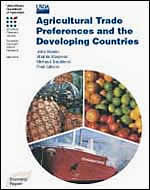Agricultural Trade Preferences and the Developing Countries
- by John Wainio, Shahla Shapouri, Michael Trueblood and Paul Gibson
- 5/20/2005
Overview
Nonreciprocal trade preference programs originated in the 1970s as an effort by high-income developed countries to provide tariff concessions for low-income countries. This study analyzes detailed trade and tariff data for the United States and the European Union (the two largest nonreciprocal preference donors) to determine the extent to which the programs have increased exports from beneficiary countries. The analysis finds that the programs offer significant benefits for some countries, mostly the higher income developing countries. Economic benefits in the least developed countries have been modest.
Download
-
Entire report
Download PDF -
Report summary
Download PDF -
cover file
Download PDF -
Abstract, Acknowledgments, Contents, and Summary
Download PDF -
Introduction
Download PDF -
Economic Rationale for Nonreciprocal Preferences
Download PDF -
United States and European Union Preference Programs Are Extensive
Download PDF -
United States and European Union Are Important Markets for Preference Recipients
Download PDF -
Preferential Tariff Advantages Remain Important
Download PDF -
Preferential Programs Are Not Fully Used
Download PDF -
Regulations Limit Use of African Growth and Opportunity Act and Everything But Arms
Download PDF -
Preferential Programs and Economic Growth
Download PDF -
Future of Preference Programs
Download PDF -
Conclusions
Download PDF -
References
Download PDF -
Glossary
Download PDF


